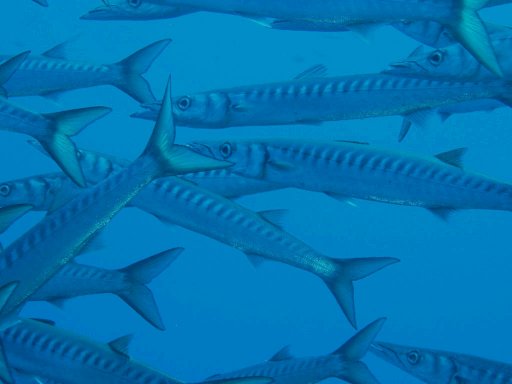
Photo copyright Andrew Reay-Robinson.
European Barracuda, Sphyraena sphyraena, taken on Secca della Columbara, Ustica, Italy.
In blue warm water, being circled by a shoal of barracuda makes for an extremely memorable dive. These silvery fish have an unfair reputation for being dangerous to divers. In reality they will not attack a person unless provoked.
Barracuda are unmistakeable fish. They are streamlined with muscular tails for bursts of speed, they have a pointed head and two widely separated fins on their backs. Top-level predators, their large mouths are filled with long, knife-like teeth. Their bottom jaws project forward. A barracuda can attack fish larger than the gape of its jaws. To swallow such large prey they repeatedly bite them and shake their heads resulting in cutting the prey in two. Their scissor-like bite is capable of shearing through the flesh and bone of its prey.
The barracuda in the picture is probably Sphyraena sphyraena - the European Barracuda - which lives in the Mediterranean Sea and thoughout the Eastern Atlantic plus in Brazil and Bemuda. The photo was taken off Ustica in Italy. (Three species of barracuda live in the Med and it is difficult to tell them apart.)
Globally there are 26 species of barracuda living in warm temperate and sub-tropical waters. Recently, with the seas warming, baracuda have been seen in more northerly waters.
The adult European barracuda is generally around 50 cm long, although a specimen has been recorded at 165 cm. The largest barracuda is the Great Barracuda (S. barracuda) at up to 200 cm long.
Barracuda school by day. Living in a group has several possible advantages: it might be that they group where the food is, and the group helps them hunt. It may also give them an advantage against their few predators. Barracuda have been found in the stomachs of tuna and dolphin; sharks may also be a threat. Whatever the reason, a school of barracuda is a treat for divers.
Further Reading
Sea Fishes and Invertebrates of the Mediterranean by Lawson Wood, Paperback, 128 pages, (2002)
The Underwater Photographer: Digital and Traditional Techniques by Martin Edge, Paperback, 536 pages (2009)


